

Giovan (Gian) Domenico Vinaccia (13 March 1625, Massa Lubrense - July 1695, Naples) was an Italian architect, goldsmith, engineer and sculptor.


Giovan (Gian) Domenico Vinaccia (13 March 1625, Massa Lubrense - July 1695, Naples) was an Italian architect, goldsmith, engineer and sculptor.
He learned sculpture and architecture from Dionisio Lazzari. His first surviving independent work was the 1661 choir stalls in San Pietro ad Aram. [1] Three years later he produced the high altar for the Royal Chapel of the Treasure of St. Januarius in Naples Cathedral, showing archbishop Alessandro Carafa who had brought St Januarius' relics to Naples. He also produced reliquaries for the Chiesa del Gesù Nuovo and designed another high altarpiece in Sant'Anna dei Lombardi, although the latter was actually carved by the Ghetti brothers. The architectural-sculptural scheme in Santa Maria dei Miracoli was also carved by him.
He also designed the facade of the Chiesa del Gesù Vecchio, the pavement and interior of Santa Maria Donnaregina Nuova, the altar in San Giuseppe dei Ruffi and the marbles in Sant’Andrea delle Dame. He collaborated with Lorenzo Vaccaro on several other works. [2]
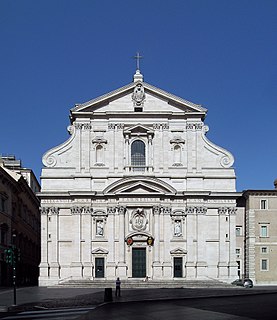
The Church of the Gesù is the mother church of the Society of Jesus (Jesuits), a Catholic religious order. Officially named Chiesa del Santissimo Nome di Gesù all'Argentina, its facade is "the first truly baroque façade", introducing the baroque style into architecture. The church served as model for innumerable Jesuit churches all over the world, especially in the Americas. Its paintings in the nave, crossing, and side chapels became models for Jesuit churches throughout Italy and Europe, as well as those of other orders. The Church of the Gesù is located in the Piazza del Gesù in Rome.
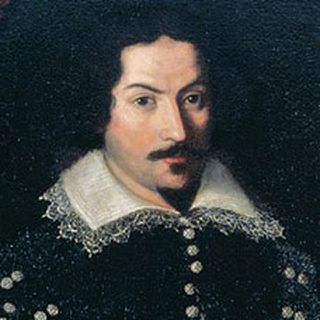
Carlo Maderno (Maderna) was an Italian architect, born in today's Ticino, who is remembered as one of the fathers of Baroque architecture. His façades of Santa Susanna, St. Peter's Basilica and Sant'Andrea della Valle were of key importance in the evolution of the Italian Baroque. He is often referred to as the brother of sculptor Stefano Maderno, but this is not universally agreed upon.
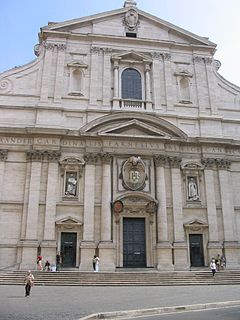
Giacomo della Porta (1532–1602) was an Italian architect and sculptor, who worked on many important buildings in Rome, including St. Peter's Basilica. He was born at Porlezza, Lombardy and died in Rome.

Cosimo Fanzago was an Italian architect and sculptor, generally considered the greatest such artist of the Baroque period in Naples, Italy.

Ferdinando Fuga was an Italian architect who was born in Florence, and is known for his work in Rome and Naples. Much of his early work was in Rome, notably, the Palazzo della Consulta (1732–7) at the Quirinal, the Palazzo Corsini (1736–54), the façade of the Santa Maria Maggiore (1741–3), and the Church of Sant'Apollinare (1742–8). He later moved to Naples and notably designed the Albergo de'Poveri (1751–81), the façade of the Church of the Gerolamini, and that of the Palazzo Giordano.
The Naples Conservatory of Music is a music school located in Naples, Italy. It is situated in the complex of San Pietro a Majella.

Sant'Anna dei Lombardi,, and also known as Santa Maria di Monte Oliveto, is an ancient church and convent located in piazza Monteoliveto in central Naples, Italy. Across Monteoliveto street from the Fountain in the square is the Renaissance palace of Orsini di Gravina.

Giacinto Brandi was an Italian painter from the Baroque era, active mainly in Rome and Naples.

Santa Maria del Rosario, commonly known as I Gesuati, is an 18th-century Dominican church in the Sestiere of Dorsoduro, on the Giudecca canal in Venice, northern Italy. The classical style building has a well-lit interior and is exceptional in preserving its original layout and Rococo decoration intact. The church and almost all its sculpture and paintings were created within a thirty-year period: construction began in 1725, the church was consecrated in 1743, and the last sculptural decoration was in place by 1755.
Charitable institutions attached to churches in Rome were founded right through the medieval period and included hospitals, hostels, and others providing assistance to pilgrims to Rome from a certain "nation", which thus became these nations' national churches in Rome. These institutions were generally organised as confraternities and funded through charity and legacies from rich benefactors belonging to that "nation". Often also they were connected to national "scholae", where the clergymen were trained. The churches and their riches were a sign of the importance of their nation and of the prelates that supported them. Up to 1870 and Italian unification, these national churches also included churches of the Italian city states.

Aspren or Asprenas was a 1st-century Christian saint and venerated as the first Bishop of Naples.

Francesco Mancini was an Italian painter whose works are known between 1719 and 1756. He was the pupil of Carlo Cignani.

Christianity and religion in general has always been an important part of the social and cultural life of Naples. It is the seat of the Archdiocese of Naples, and the Catholic faith is highly important to the people of Naples and there are hundreds of historic churches in the city. The Cathedral of Naples is the most important place of worship in the city, each year on September 19 it hosts the Miracle of Saint Januarius, the city's patron saint. In the miracle which thousands of Neapolitans flock to witness, the dried blood of Januarius is said to turn to liquid when brought close to relics said to be of his body: this is one of the most important traditions for Neapolitans.
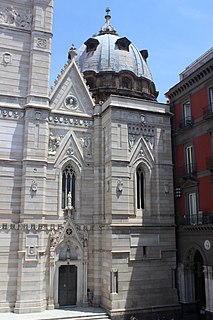
The Royal Chapel of the Treasure of St. Januarius, or the Reale cappella del Tesoro di San Gennaro, is a chapel located in the Cathedral of Naples, Italy, and dedicated to St. Januarius, patron saint of the city. This is the most lavishly decorated chapel in the Cathedral, and contains contributions by the premier Baroque artists in Naples.

The church of Santi Severino e Sossio and the annexed monastery are located on via Bartolommeo Capasso in Naples, Italy.
Arcangelo Guglielmelli was an Italian architect and painter, active in his native Naples, Italy, in a late-Baroque style. He was involved in the building and reconstruction of churches, many of which had been damaged by the earthquakes of 1688 and 1694.

Paolo Posi was an Italian architect of the late-Baroque period. Among the cities in which he was active were Rome, Narni, and Viterbo. Among the other works, he designed mausoleums for Cardinal Inico Caracciolo in Aversa, Cardinal Giuseppe Renato Imperiali in the church of Sant'Agostino in Rome, for cardinal Carafa in Sant'Andrea delle Fratte (1759), and for princess Maria Flaminia Chigi-Odescalchi (1771) in the church of Santa Maria del Popolo.
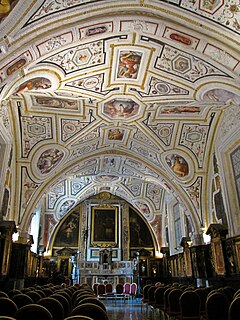
The Vasari Sacristy or Old Sacristy is a room in Sant'Anna dei Lombardi, Naples, Italy, one of its two sacristies. It was the refectory of the Olivetan monastery of Santa Maria di Monteoliveto until 1688, when it was converted to its current role. The conversion in 1688 revealed 15th century inlays by Fra Giovanni da Verona, also to be seen in the church's Tolosa Chapel. The church was renamed Sant'Anna dei Lombardi in 1805.